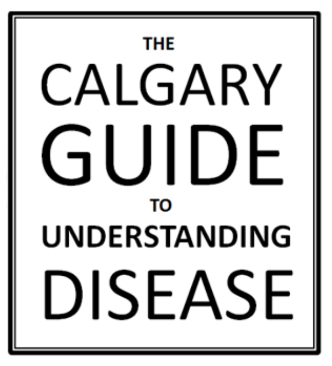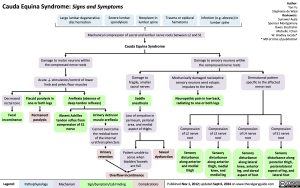Cauda Equina Syndrome: Signs and Symptoms
Author: Yan Yu Stephanie de Waal Reviewers: Sunawer Aujla Spencer Montgomery Owen Stechishin Michelle J Chen W. Bradley Jacobs* * MD at time of publication
Large lumbar degenerative disc herniation
Severe lumbar spondylosis
Neoplasm in lumbar spine
Trauma or epidural hematoma
Infection (e.g. abscess) in lumbar spine
Mechanical compression of sacral and lumbar nerve roots between L2 and S1
Cauda Equina Syndrome
Damage to motor neurons within the compressed nerve roots
Acute ↓ stimulation/control of lower limb and pelvic floor muscles
Damage to fragile, smaller sacral nerves
Saddle anesthesia
Loss of sensation in perineum, perianal
area, and medial aspect of thighs
Patient unable to sense when bladder/ bowels are full
Damage to sensory neurons within the compressed nerve roots
Mechanically damaged nociceptive sensory neurons send ectopic impulses to the brain
Neuropathic pain in low back, radiating to one or both legs
Dermatomal pattern specific to the affected nerve root
Decreased rectal tone
Fecal incontinence
Flaccid paralysis in one or both legs
Permanent paralysis
Areflexia (absence of deep tendon reflexes)
Absent Achilles tendon reflex from compression of S1 nerve
Urinary detrusor muscle areflexia
Cannot overcome the residual tone of the internal urethral sphincters
Urinary retention
Compression of L2 nerve root
Sensory disturbance
along anterior and medial thigh
Compression of L3 nerve root
Sensory disturbance along anterior thigh, medial knee, and medial leg
Compression of L4 nerve root
Sensory disturbance along lateral knee, anterior leg, and dorsal aspect of foot
Compression of S1 nerve root
Sensory disturbance along posterior thigh, posterolateral aspect of leg, and lateral foot
Sexual dysfunction
Overflow incontinence
Legend:
Pathophysiology
Mechanism
Sign/Symptom/Lab Finding
Complications
Published Nov 1, 2012; updated Sept 6, 2024 on www.thecalgaryguide.com

